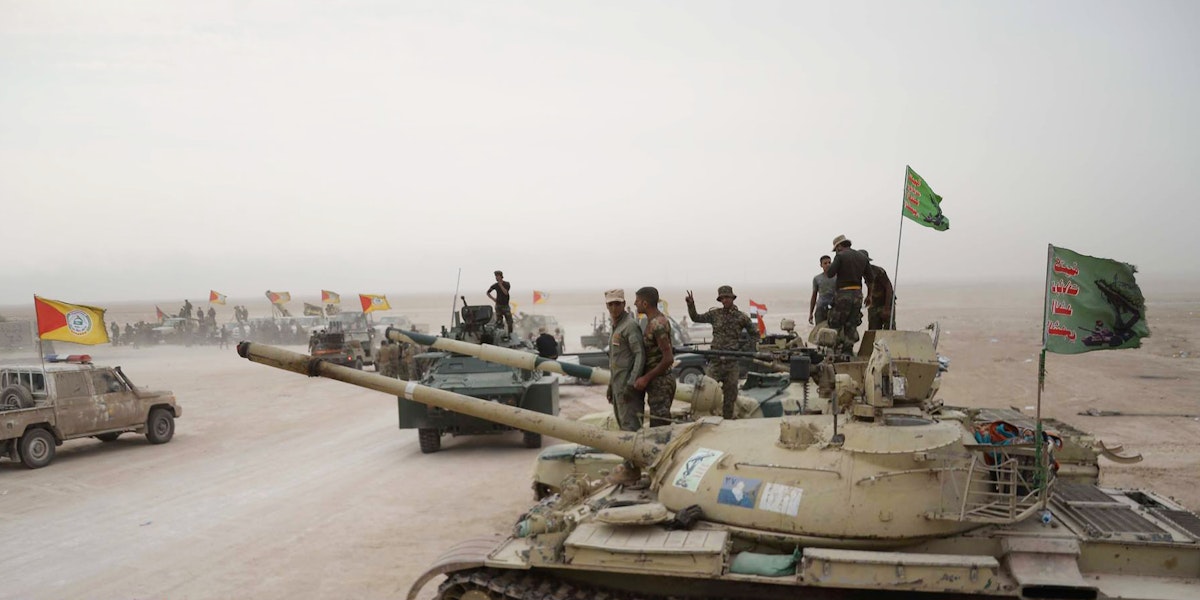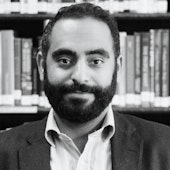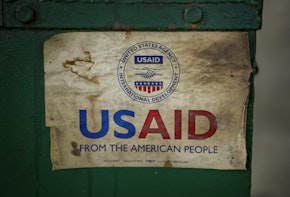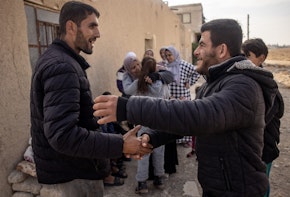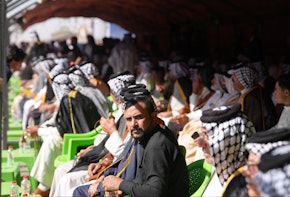When the Iraqi army crumbled to the Islamic State in 2014, the Popular Mobilization Units (PMU, or Al-Hashd al-Shaabi in Arabic), an umbrella organization of some sixty predominantly Shia paramilitaries and some 110,000 fighters with varying ideological and political stances, stepped in to defend and slowly take back Iraqi territory. Today, it remains one of the main allies in Iraq’s fight against the Islamic State (also known as ISIS). This sprawling new militia-complex is fast solidifying as an entrenched parallel state army. Some of its leadership has political ambitions, injecting another long-term obstacle to the writ of the central government in Baghdad and its hopes of reversing the fragmentation and entropy that hobbled state-building efforts in Iraq.
In January 2017, Amnesty International issued a damning report claiming that PMU groups were committing war crimes.1 In the battle against the Islamic State, such allegations against the PMU are not new. A month before, in December 2016, Human Rights Watch reported that a Sunni PMU associated militia, the Hashd al-Jabour, executed four suspected ISIS affiliates without any judicial proceeding—a war crime.2 Such allegations are also not a recent phenomenon. Long before the formation of the PMU and for much of post-2003 Iraq, international human rights watchdogs3 and media agencies have consistently accused these militias of war crimes.4
Yet, this time, there is something different. The PMU began its official response with a stark declaration: “The al-hashd al-shaabi is not an ally of the Iraqi government, it is a part of the Iraqi government” (emphasis added).5 The distinction signifies a fundamental shift in Iraqi state-building: the central government is no longer looking to integrate or reign in the militias, but rather to recognize (and therefore legitimize) the militias as state entities parallel to the Iraqi Security Forces. To many Iraqis, particularly but not exclusively the majority Shia population, the PMU is a legitimate group of fighters defending their country from ISIS and its brutality.
The question, then, is how to reconcile these two contrasting perceptions of the PMU: a sectarian-motivated Iranian-backed group of militias that commit war crimes versus a state-recognized force defending Iraq from ISIS and other insurgent groups. Answering this question is significant, as even after the liberation of Mosul and the eradication of the Islamic State’s control of Iraqi territory, the PMU will likely remain a permanent fixture. It will not simply integrate or go away.
The Legitimization of the PMU
Since 2014, PMU leaders have embarked on a threefold process of legitimizing the umbrella organization.
They first pushed for state recognition.6 In June 2014, Prime Minister Nouri al-Maliki created the Popular Mobilization Units Commission (haya’t al-hashd al-shaabi). The legitimization continued under Abadi, who in February 2016 issued an executive order (No. 91) recognizing the PMU.7 One of its leaders, Abu Mahdi al-Muhandis, went to Abadi in 2015 asking for the prime minister’s office to begin paying its salaries. Since then, the state pays $1 billion annually to the PMU commission.8 The Iraqi parliament cemented the PMU by passing into law its recognition as a separate security entity in November 2016. The PMU’s administer, al-Muhandis, who the United States’ designates as a terrorist, is vying to become part of the Iraqi state. He even rides on Iraq’s official air force carriers.9
https://twitter.com/jamal_gaafer/status/818538463628759043
They then took top Shia cleric Grand Ayatollah Ali al-Sistani’s 2014 fatwa, which called on all able citizens to volunteer to the state’s “security forces.” Although Sistani meant for the volunteers to join the police or army, Maliki and other PMU leaders interpreted this ruling as justifying the paramilitaries. Maliki claimed that it was a part of the state’s security forces and in line with the fatwa by pointing to the state-recognized PMU commission, which he had recently created as prime minister.
To further the legitimization process, they began highlighting the PMU’s fighting power and success against ISIS—vis-à-vis the embarrassing collapse of the Iraqi military in 2014. This also includes showcasing martyrs who died defending their country. In a way, the PMU leaders pitched their umbrella organization as the most successful institution since regime change, and invoked a sense of pride amongst many Iraqi Shia citizens, who were searching for such an organization since 2003.
Divergent Views of the PMU
Today it is clear that the legitimization process has worked. Inside Iraq, the popular perception of the PMU among Iraqis—and particularly the Shia—is far more favorable than the group’s reputation among Western politicians, analysts, and human rights groups. For the Shia, Sunni, Kurdish leadership, the PMU has become a permanent fixture. Iraqis consider 2014 to be an embarrassing year as their military crumbled to a peripheral salafi-jihadi organization numbering in the mere thousands. Many Iraqis, and particularly the Shia, are convinced that had it not been for the PMU, ISIS would have taken over more territory and seriously threatened Baghdad. To them, in many of the original battles to re-take Iraqi territory, it was the PMU that had to fill in for a damaged state security apparatus.
The PMU occupies a new space in the Iraqi Shia imagination. As one fighter told the author, “you can criticize any politician or even religious cleric, but you cannot speak against the PMU and its martyrs.” To many, these martyrs have given up their lives in defense of their country. Many of the Shia feel like they’ve finally found a strong and capable institution that can represent post-2003 Iraq. They struggled for many years to find any success and points of pride in their state-building process. Iraqi society is now full of popular songs, commercials, and banners, which display the leaders and martyrs of the different military groups.
It is not only the Shia who recognize the PMU. In the battle over Mosul, Sunni, Christian, Turkmen, and other ethno-religious based fighting groups have joined or interact with the PMU.
A growing number of Iraq’s Sunnis are recognizing the PMU and engaging with some of its paramilitaries. In December 2015, Prime Minister Haider al-Abadi approved the inclusion of 40,000 Sunni fighters into the PMU.10 For instance, the Ali al-Akbar Brigades includes some 20 percent Sunni fighters.11 Since 2014, the Jabour tribe, mentioned above by HRW, has been cooperating with PMU paramilitaries in Dhuluiya. For them, it’s better to go to the PMU than the state to receive funding and arms. One tribal leader from Salahadeen joked to the author that the funding scheme means that perhaps Sunnis will defend the PMU more than the Shia. Former Governor of Ninewah (Mosul) Athil al-Nujaifi, who heads a paramilitary outfit of local Moslawis, decided to join the PMU in October 2016. According to Nujaifi’s team, this decision was primarily based on gaining access to PMU funds and attempting to keep relations with powerful Shia members open in a post-ISIS Iraq. Nujaifi’s Ninewah Guards, which is made up mainly of Sunni fighters, is now on the PMU payroll.12 Indeed, the Sunnis who have joined the PMU enjoy an enhanced position, and may ironically become one of its strongest supporters.
In effect, many of the same Sunni tribal groups who were willing to join forces with the United States military against jihadi groups in what became known as the Sunni “Awakening” in 2008 are now making the same kind of arrangement with Shia paramilitaries in the PMU—with many of the same pathologies and risks that ultimately undid the American Awakening. Today, the PMU—rather than the Iraqi government, or the United States—is financing the Sunni tribal groups. This time, however, it is even more explicitly a marriage of convenience: The Sunnis need the money and weapons to fight against ISIS on their lands and to ensure supremacy of their tribe in intra-Sunni contestations, and the PMU need the tribes to fight ISIS and to enhance its cross-sectarian legitimacy.
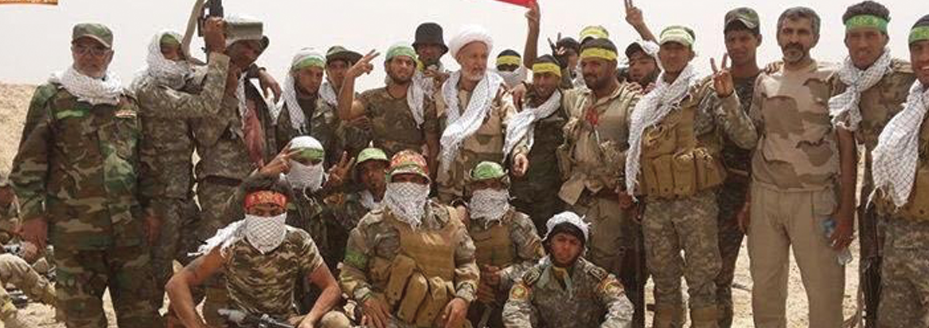
Yet, at the same time, other Sunni leaders remain wary of PMU ambitions in northern Iraq. For instance, they believe that the PMU’s battle in Tal Afar, a Turkmen town, is based on seeking vengeance against Sunnis as well as creating a corridor for Iran towards the Mediterranean. They perceive the predominantly-Shia PMU to be part of the root causes of Iranian supremacy in Iraq. The PMU’s “godfather,” an expression used by a senior PMU leader, is Nouri al-Maliki—the same person who mismanaged and ultimately lost the original Awakening. Therefore, this marriage of convenience is at risk of only being temporary.
The Kurds, too, have expressed willingness to deal with the PMU. They also know that the PMU is a legitimate negotiating partner. An official inside the Kurdistan Security Council confided to the author that his leadership is willing to engage with the likes of Hadi al-Ameri, a senior PMU official and the leader of the largest paramilitary, the Badr Organization.
At the same time, the Kurdistan Region’s leadership remain wary of other PMU officials, such as Qais Khazali, who leads the controversial League of Righteousness (Asaib ahl al-Haq). Khazali stated in December, “after ISIS, Kurds are the greatest problem, especially Masoud Barzani.13 And solving the problems or peace with them is impossible.”
There is a general recognition amongst Iraqi political leaders that the organization is worth engagement.
In short, although it has been legitimized, there is no coherent line across Iraq on the PMU. But there is a general recognition amongst Iraqi political leaders that the organization is worth engagement.
Not a Singular Organization: Sacred Units or Imprudent Militias?
Part of this incoherence that leads to different perceptions of the PMU is because it is not a single organization. It does not have a single leadership structure or unified ideological stance. Rather, it is a myriad of organizations with very different ideological viewpoints. These organizations often contest each other. In most general terms, the main leadership of the PMU can be classified based on ideological underpinnings: pro-Khamenei, pro-Sistani, or pro-Muqtada al-Sadr.
The greatest contestation in Iraqi Shia politics is between two leaders: Nouri al-Maliki and Muqtada al-Sadr.14 This has been the case for much of post-2003 Iraq and has a PMU component. Understanding this power dynamic offers clues into the divergence in viewpoints of the PMU.
Many in the pro-Khamenei group, which represents the most powerful paramilitaries, look to Maliki as the founder of the PMU. Those in this group often refer to the PMU as the Sacred Mobilization Units (al-hashd al-muqadis). They contain many of the original Shia militias that existed before ISIS took over many Iraqi towns and cities.
This group controls the PMU commission, which is the state-approved entity set up by Maliki in June 2014. Abadi pays the commission, which then pays 110,000 of its fighters. This faction of the leadership has access to the state’s allocation of resources.Abu Mahdi al-Muhandis acts as the chief administrator. Therefore, it is the more influential group. Both Sadr and Sistani’s groups have complained about not being paid enough from the commission, which they accuse of favoring the pro-Khamenei paramilitaries.
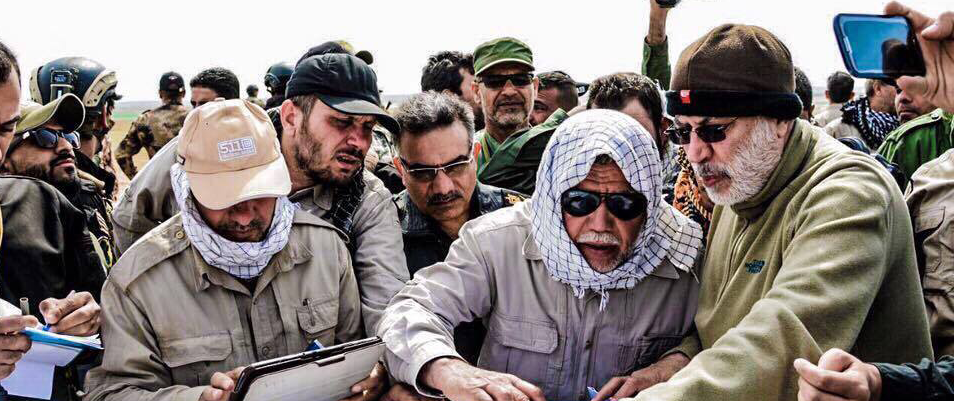
The Khamenei faction’s leaders pledge allegiance to the authority of Iranian Supreme Leader Ali Khamenei. As such, they also enjoy greater sources of funding and supplies from Tehran. The main leaders in this group include Maliki, Hadi al-Ameri, Qais Khazali, Abu Mahdi al-Muhandis, among others. They work between Abadi’s office and Qassim Sulaimani, the leader of the IRGC’s Quds Force. However, the leaders do not report to the prime minister. They at times even work to undermine Abadi.
Because the main actors in this group existed before ISIS, it is likely that they will continue to exist after ISIS is removed from Mosul. Many of them are also political actors. Hadi al-Ameri’s Badr Organization, for instance, have twenty-two members of parliament in parliament. In fact, Maliki attempted to change his electoral coalition’s official name from “State of Law” to “PMU.” He will try and use the legitimacy of the PMU to regain power, himself, or via his protégés. Other leaders, including Ameri, will also look to use their role in the fight against ISIS to further political aspirations. Ameri was upset when Abadi passed him over for Minister of Interior, and is looking to make a political comeback.
In direct contrast to this is Muqtada al-Sadr’s Peace Brigades (Sarayat al-Salam)—a successor to the Mahdi Army, which was suspended in 2008 but kept much of its cadres and expertise and social networks.15 Although he takes part in the PMU, Sadr opposes it on principle, because he claims it undermines the institutions of a central state. He also opposes the pro-Khamenei leadership’s monopoly of power. At times he refers to the PMU as the Imprudent Militias (al- milishiat al-wahika).16 His representatives have also presented a confused line by occasionally claiming that they are not actually in the PMU. Sadr representatives have complained that the PMU commission, which is the state-recognized body tasked with distributing salaries, favours the previous group and does not send any funding to Sadrist fighters. Sadr has the ability to bring together a 100,000 strong army but is restricted due to funding and military hardware. He remains critical of the pro-Khamenei groups and of Iranian interference inside Iraq.
Sadr prefers to support the state security apparatus. Many have analyzed his transformation from a firebrand cleric to a nationalist agitator in Iraqi politics.17 However, he will likely not let go of his Peace Brigades as long as the stronger groups in the PMU exist. He sees himself in battle against the likes of Maliki and Khazali, who is a former Sadrist lieutenant.
Although part of the umbrella organization, the pro-Sistani groups are not in direct line of the above main conflict. Most of them are small apolitical paramilitaries that formed following Sistani’s fatwa to defend against the so-called Islamic State. There are four major groups organized from Najaf: Saraya al-Ataba al-Abbasiya, Saraya al-Ataba al-Hussainiya, Saraya al-Ataba al-Alawiya, and Liwa ‘Ali al-Akbar. Like the Sadrists, these factions often complain that the state-recognized PMU Commission does not pay them.
This category also includes the paramilitaries of Ammar al-Hakim and the Islamic Supreme Council of Iraq, which switched allegiances from Khamenei to Sistani in 2007. These are Saraya el-Jihad, Saraya el-‘Aqida, Saraya ‘Ashura, among others. Hakim once led Ameri and the Badr Organization, but infighting led to a breakup. Part of this was because of ISCI’s official shift in allegiance from Khamenei to Sistani. Hakim’s influence is nonetheless waning and marginal when compared to the Maliki-Sadr struggle.
These groups will likely be the first to dissolve after ISIS is removed from governing Mosul and the rest of Iraq. In fact, Sistani remains very critical of the powerful pro-Khamenei leadership of the PMU. This stems from his annoyance over the misuse of his fatwa, which was intended to prompt volunteers to join the state apparatus and not the militias.
What Happens Next?
Prime Minister Haider al-Abadi, who represents the Iraqi state, is under pressure to come up with a solution for the security sector in post-ISIS Iraq—or at least, an Iraq where the government is once again in control of the country’s second city, Mosul. There is no question that the PMU has become a permanent institution of the Iraqi security apparatus. In the fight against ISIS, many Shia, Sunni, and Kurdish leaders deal with the PMU as an arm of the Iraqi state.
The looming question, though, is what comes next. The traditional wisdom for post-conflict settlement is to integrate or reign in the militias into a strong state apparatus. Rather than integrate, though, Abadi is under pressure to recognize the PMU as an official institutional power center and arm of the state’s security apparatus. Some have even drawn pointed to establishing a force akin to the Iranian Revolutionary Guards Corps—a para-state and autonomous military entity. Others, particularly the pro-Sadr and pro-Sistani groups, remain critical and would like to see the PMU groups integrated into the Iraqi ministry of interior or defence.
Abadi’s plan is to maintain the PMU as a special force under the auspices of the commission. His Order 91 states that the PMU will be “an independent military formation and a part of the Iraqi armed forces, and linked to the general commander of the armed forces.”18 A parliamentary law on the PMU, passed in November 2016, calls for turning the PMU into an official security institution, which would include 50,000 fighters (10,000 of which would be Sunni).19 Abadi, though, has expressed his preference to only pay some 25,000 of its fighters who would fall into this arm. He would also like to pay each fighter directly. However, it is more likely that he will continue paying the commission, which will then redistribute and operate under a degree of financial autonomy. Looking ahead, PMU spokesman Ahmed al-Asadi told the author, the commission will also work to get rid of militia names and instead rename them as numbered divisions, so that, for example, Asaib Ahl al-Haq would become of the eighth, ninth, and tenth divisions of the PMU.
The state’s current plan has several shortcomings, however. The PMU’s chief negotiators, making up the pro-Khamenei group, are the power behind the commission. They want to have more funding from the government yet remain autonomous. More critically, they have in the past undermined Abadi, and will try and do so if they disagree with his decisions. Although Abadi will be strengthened following an imminent victory in Mosul, he will have to reach a compromise with Maliki, Ameri, and others who are vying to regain power in the central government.
Moreover, many Sunni leaders are going to the PMU, not the central government, to receive funds and arms in the fight against ISIS. This represents a new Sunni Awakening—with increased numbers of Sunnis joining the PMU in order to access its funds. However, this “Sunni Awakening 2.0” under which the tribal fighters are paid by the PMU and not by the state is problematic. Several of the PMU leaders under the pro-Khamenei wing, including Khazali and Maliki, have had issues with the Sunni population in the past. It was Maliki who stopped funding the tribes and who was unable to maintain the first Awakening. Sunnis remain fearful that their funding will vanish and their leaders will be imprisoned just as the previous awakening dissolved into a going to sleep in Maliki’s jails. They fear that the current marriage of convenience will not last long in an Iraq, where ISIS no longer controls significant territory and serves as a common enemy to unite differing parties.
As soon as ISIS is removed from governing territory, Iraq will face a new opportunity for state-building.
To some extent, the PMU model of localization seems to be the replacement of the failed National Guard model intended for post-2003 Iraq. However, at the moment, the state has very little control over the paramilitaries. As soon as ISIS is removed from governing territory, Iraq will face a new opportunity for state-building. Decisions made and compromises reached at this time will shape the future of the state. They will also reveal whether ISIS is permanently removed or whether another Salafi-jihadi organization will re-emerge years ahead. Addressing the role of the PMU vis-à-vis the Iraqi state is an important aspect of this renewed process.
Notes
- Iraq: End irresponsible arms transfers fuelling militia war crimes,” Amnesty International, January 5, 2017, https://www.amnesty.org/en/latest/news/2017/01/iraq-end-irresponsible-arms-transfers-fuelling-militia-war-crimes/.
- “Iraq: Executions by Government-Backed Militia,” Human Rights Watch, December 18, 2016, https://www.hrw.org/news/2016/12/18/iraq-executions-government-backed-militia.
- “Absolute Impunity: Militia Rule in Iraq,” Amnesty International, October 2014, https://www.amnesty.org.uk/sites/default/files/absolute_impunity_iraq_report.pdf.
- Ned Parker and Jonathan Landay, “Special Report: Massacre reports show U.S. inability to curb Iraq militias,” Reuters, 23 August 2016, http://uk.reuters.com/article/us-iraq-massacres-falluja-special-report-idUKKCN10Y1VD.
- “PMU Response to the Amnesty International Report,” PMU Commission, January 6, 2017, http://al-hashed.net/2017/01/06/%D8%B1%D8%AF-%D8%A7%D9%84%D8%AD%D8%B4%D8%AF-%D8%A7%D9%84%D8%B4%D8%B9%D8%A8%D9%8A-%D8%B9%D9%84%D9%89-%D8%AA%D9%82%D8%B1%D9%8A%D8%B1-%D9%85%D9%86%D8%B8%D9%85%D8%A9-%D8%A7%D9%84%D8%B9%D9%81%D9%88-%D8%A7/.
- Renad Mansour, “From Militia to State Force: the Transformation of al-Hashd al-Shaabi,” Diwan, November 16, 2015.
- “Al-Sabah Al-Jadeed Publishes Special Text of the Restructure and Regulation of the Popular Mobilization Units Commission,” Al-Sabah Al-Jadeed, July 27, 2016.
- “Baghdad Times Publishes Abu Mahdi al-Muhandis’ Letter to Prime Minister Haider al-Abadi,” Baghdad Times, October 21, 2015, https://www.baghdad-times.net/2015/10/21/%D8%A8%D8%BA%D8%AF%D8%A7%D8%AF-%D8%AA%D8%A7%D9%8A%D9%85%D8%B2-%D8%AA%D9%86%D8%B4%D8%B1-%D8%B1%D8%B3%D8%A7%D9%84%D8%A9-%D8%A7%D8%A8%D9%88-%D9%85%D9%87%D8%AF%D9%8A-%D8%A7%D9%84%D9%85%D9%87%D9%86%D8%AF/.
- Picture posted on Jamal Gaafer’s Twitter account, January 9, 2017, https://twitter.com/jamal_gaafer/status/818538463628759043.
- “Sunni Satisfaction from Abadi after a Guarantee of 40,000 Fighters in the Hashd and of the Monthly Salaries for IDPs,” Al-Mada Press, December 20, 2015, https://www.almadapress.com/ar/NewsDetails.aspx?NewsID=61631.
- Robert Tollast, “Inside Iraq’s Popular Mobilization Units,” The National Interest, May 23, 2016, http://nationalinterest.org/feature/iraqs-shia-militias-arent-bad-you-think-16291?page=3.
- PMU Commission Distributes Salaries to the Ninewah Guard,” Ninewah Tomorrow T.V. Channel, January 3, 2017, https://www.youtube.com/watch?v=Kjejl9KLuOo.
- “After ISIS, Iraq’s biggest problem is Kurds, says Shiite militia leader,” Rudaw, December 13, 2016, http://www.rudaw.net/english/kurdistan/131220162.
- Renad Mansour, “The Political Battles in Baghdad after the Battle for Mosul,” War on the Rocks, October 3, 2016, https://warontherocks.com/2016/10/the-political-battles-in-baghdad-after-the-battle-for-mosul/.
- “Iraq’s Muqtada Al-Sadr: Spoiler or Stabiliser?,” International Crisis Group, Middle East Report Number 55, July 11, 2006, https://d2071andvip0wj.cloudfront.net/55-iraq-s-muqtada-al-sadr-spoiler-or-stabiliser.pdf.
- Sadr: Army Victories Provoke the Imprudent Militias,” Al-Mada Press, January 26, 2016, https://almadapress.com/ar/news/63657/%D8%A7%D9%84%D8%B5%D8%AF%D8%B1-%D8%A7%D9%86%D8%AA%D8%B5%D8%A7%D8%B1%D8%A7%D8%AA-%D8%A7%D9%84%D8%AC%D9%8A%D8%B4-%D8%A7%D8%B3%D8%AA%D9%81%D8%B2%D8%AA-%D8%A7%D9%84%D9%85%D9%8A%D9%84%D9%8A%D8%B4.
- Ibrahim al-Marashi, “Iraq: The reinvention of Muqtada al-Sadr,” Al-Jazeera, March 9, 2016, http://www.aljazeera.com/indepth/opinion/2016/03/iraq-reinvention-muqtada-al-sadr-160309061939234.html.
- l-Sabah Al-Jadeed, “Al-Sabah Al-Jadeed Publishes Special Text of the Restructure and Regulation of the Popular Mobilization Units Commission,” July 27, 2016.
- “PMU Draft Law Includes Demobilizing Two-Thirds of its Fighters without Pension,” Al-Mada Newspaper, November 14, 2016, http://www.almadapaper.net/ar/news/519961/%D9%85%D8%B3%D9%88%D8%AF%D8%A9-%D9%82%D8%A7%D9%86%D9%88%D9%86-%D8%A7%D9%84%D8%AD%D8%B4%D8%AF-%D8%AA%D8%AA%D8%B6%D9%85%D9%86-%D8%AA%D8%B3%D8%B1%D9%8A%D8%AD-%D8%AB%D9%84%D8%AB%D9%8A-%D8%A7%D9%84%D9%85%D9%82%25.
